It’s finally paw paw time in eastern Ohio. I’ve been keeping an eye on several patches of these trees in the woods near my home, watching their development from small, peanut-sized fruits, and eagerly anticipating their ripening into mango-sized beauties!
For those of you who are unfamiliar with this one, the paw paw (Asimina triloba) is a small deciduous tree native to the eastern US from zones 5-8, that produces the largest native fruit of North America. It’s closely related to the ylang-ylang, soursop, and custard apple, though unlike its tropical relatives, the paw paw is the only member of its family to grow in temperate climate zones. It prefers to grow in very fertile, well-drained, hilly woods in the shade of larger trees. This Old Earth gem of the woods has been cherished by Native American peoples for hundreds of years before introducing it to European colonists. On an interesting side note, its leaves are the only known food source for zebra swallowtail caterpillars. For you herbalists out there, a decoction of the inner bark is a natural insecticide and an effective remedy for head lice.
The fruit is not only nutritious, but absolutely delicious! When ripe it has the texture of a banana with the juiciness of a mango. The flavor far surpasses any other fruit, in my opinion. I’d say it tastes like a cross between a banana, a mango, and vanilla custard. It has more vitamin C than an orange, and more potassium than a banana. It’s also the only fruit known to contain ALL essential amino acids. But perhaps my most favorite thing about the paw paw is that you’ve got to connect with nature in order to enjoy it. This fruit is a unique gift of the eastern woodlands, which is where you have to go to find it. The only other way to get it is to grow it yourself from seed which takes time. It is not commercially available because the fruit bruises easily and has a very short shelf life when picked.
Once you find a patch of paw paws, you’ve got to keep an eye on them as autumn approaches because the window of opportunity is small and humans are by no means the only creatures eagerly awaiting their ripening. Birds, deer, foxes, coyotes, opossums, squirrels, and raccoons all love them, so if you wait too long, they WILL beat you to them. As soon as they ripen they begin to fall to the ground, especially on windy or stormy days/nights. Before this point I will typically check them once a week as autumn draws near, by gently squeezing a few fruits from multiple groves. (Some groups ripen before others depending on individual micro-climates) Technically, if you want to get ahead of the competition, there’s a point of early ripeness when you can pick them. Once they soften enough to give under a little pressure, like a peach or avocado, they’ll be ready for picking. This way, you’ll get them before they fall within easy reach of most critters. Even though they’re ready for picking at this point and can be eaten, you’ll want to let them set at room temperature for a few days to a week for the flavor to develop as they fully ripen. Also keep in mind that unless they are at the stage of early ripeness when you pick them, they won’t continue to ripen after being picked like other fruits will. So there’s no point in picking them before this point.
As mentioned earlier, the fruits don’t keep well as they have a short shelf life. But you can extend your harvest by slowing their ripening in the refrigerator. For the best flavor, you’ll want them to get ridiculously ripe. Like bananas, they will turn brown or black, but this is good news for paw paws. You’ll experience the fullest flavor at this point; though don’t wait so long that they begin to shrivel. To eat them, it’s just a matter of cutting into them length-wise all the way around and twisting them into two halves, like you would an avocado. There will be multiple seeds in a row down the center. You can pop them out or eat around them with a spoon, scooping the flesh out from the skin. If you’re a fruit connoisseur, it’s easily the tastiest fruit you’ll ever enjoy and the most rewarding to obtain.
If you’ve somehow managed to eat your fill, or have collected enough to carry you into the winter months; the best way to preserve them is to scoop out the pulp and freeze it. It keeps very well this way and retains a good flavor upon thawing. It will oxidize a little bit, turning light brown once frozen, but it won’t affect taste or quality. Paw paw puree has a million and one culinary uses, though I’ve yet to experiment with it very much. However, I have found that it makes an incredible smoothie (try it with ice cream) and makes a better substitute for any recipes calling for bananas. I plan on trying a batch of paw paw bread this season. I can hardly wait!
As excited as I am with what I’ve collected so far, there are far more out there that have not quite ripened enough for picking yet. I’m eager to get back out there in a few days to a week and grab some more. So to anyone out there in zone 5 with access to some uncorrupted, healthy woods….. Now’s the time to start looking! Get out there! You’ve got maybe a couple of weeks!
One quick point I’d like to make, is to be respectful of whichever woods you choose to search for or collect this fruit (or any natural resource for that matter). Since you’ll likely be off trail, be mindful of where you’re stepping at all times, not just for your own safety, but for the well-being of other life forms in the woods as well, plant and animal alike. When collecting any wild edibles, be mindful of the “rule of thirds.” That is, take no more than 1/3rd of what’s available in any given area, leaving 1/3rd for the other animals that rely on the same food source and 1/3rd for the plant’s own purposes. Though, since paw paw trees rely on their fruit being eaten in order to propagate themselves, you can get away with taking a bit more so long as you don’t throw the seeds in the trash after you eat the fruits. In fact I always make a point of saving every viable paw paw seed in order to show my thanks by planting those seeds in suitable locations to further the species. Remember, we humans are not the only species around with needs and we all rely on each other in the big picture anyway. So let’s keep and preserve the balance so that we can continue to enjoy this marvelous fruit for generations to come!
Mitakuye oyasin! Unci Maka, tecihila na lila pilamaya lo!
~Mato Inila (Steve)~
You can see how easy to miss they are if you’re not looking for them.
Three of a kind!
Doubles!
A full house!
When there are multiple fruits in a cluster, it’s best to wait until all three are ready to pick, rather than risk damaging the skin of the unripe ones.

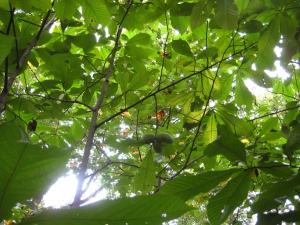
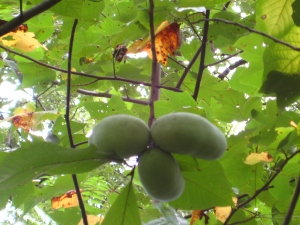
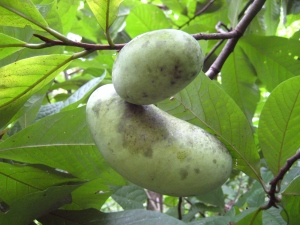
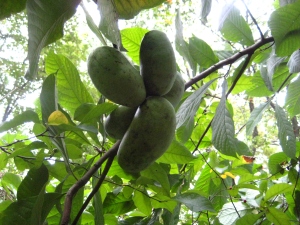
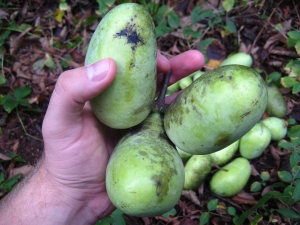
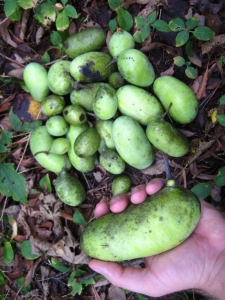
Nice man, I look forward this time every year.paw paws are my favorite of the wild edibles in this area.You gotta try that paw paw bread, Ma makes it and its fantastic!
Definitely looking forward to it! We’ve already got ten lbs of paw paw puree we’ve frozen thus far, so we’ll be doing some experimenting this year…. Excited for mushroom season beginning soon too!